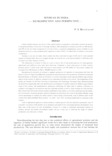Soybean in India - Retrospective and Perspective -
Tropical agriculture research series : proceedings of a symposium on tropical agriculture researches
| ISSN | 03889386 |
|---|---|
| 書誌レコードID(総合目録DB) | AA00870529 |

本文フルテキスト
tars17-_11-22.pdf1.77 MB
Unless suitable measures are taken in time, rapid increase in population could further increase the gravity of the global problem of food and oil shortage. Soybean, often designated as miracle crop with over 40% protein and 20% oil, has now been recognized all over the world as a potential supplementary source of edible oil and nutritious food. In a society predominantly vegetarian as that of India, the importance of soybean is even more conspicuous.
Soybean is not new for India: black soybean has been cultivated for ages in hills and in some scattered pockets of Central India. However strangely enough, the crop has not so far become popular in the Indian subcontinent and other tropical countries.
The importance of soybean in India as a crop to narrow the oil and protein gap has now been generally appreciated and ambitious plans have been drawn-up. Compared to pulse crops grown in India, soybean produces about 2.5 times more yield with twice as much protein and 20% edible oil. Area under soybean has increased from 300 hectares in 1968 to 900,000 hectares in 1982.
Recognizing the potential of soybean to augment production of vegetable oil and protein-rich food, the Indian Council of Agricultural Research, launched the multi-locational inter-disciplinary All India Coordinated Research Project on Soybean. There are 19 centers involved in the project which represent different agro-climatic regions of the country. In addition, research is also undertaken elsewhere in the country. The headquarters of the project are located at G. B. Pant University of Agriculture and Technology, Pantnagar, India. Research during the period has sequentially led to the identification/development of suitable varieties for different agro-climatic zones of the country and standardization production technology for high yield of soybean. Utilization of soybean is envisaged for oil extraction and use of defatted soybean as well as whole soybean for food and feed. Out of more than 120 solvent extraction plants established in the country, several have started processing soybean
for oil extraction. Extrusion products based on defatted soya flour have also come in the market. Recipes, using various percentages of soybean for dishes similar to those being conventionally used in different parts of the country have been published. More recently, "soy milk" and "tofu" are being popularized in some parts of the country.
Lack of appropriate agencies to ensure market to soybean growers and raw material to processors, want of consumers' awareness of the benefits of soy products and need for low cost product process development, have been some of the reasons for slow development. Creation of a center to undertake operational research on product, process and market development studies will go a long way in achieving the target of soybean production and utilization in India.
Soybean is not new for India: black soybean has been cultivated for ages in hills and in some scattered pockets of Central India. However strangely enough, the crop has not so far become popular in the Indian subcontinent and other tropical countries.
The importance of soybean in India as a crop to narrow the oil and protein gap has now been generally appreciated and ambitious plans have been drawn-up. Compared to pulse crops grown in India, soybean produces about 2.5 times more yield with twice as much protein and 20% edible oil. Area under soybean has increased from 300 hectares in 1968 to 900,000 hectares in 1982.
Recognizing the potential of soybean to augment production of vegetable oil and protein-rich food, the Indian Council of Agricultural Research, launched the multi-locational inter-disciplinary All India Coordinated Research Project on Soybean. There are 19 centers involved in the project which represent different agro-climatic regions of the country. In addition, research is also undertaken elsewhere in the country. The headquarters of the project are located at G. B. Pant University of Agriculture and Technology, Pantnagar, India. Research during the period has sequentially led to the identification/development of suitable varieties for different agro-climatic zones of the country and standardization production technology for high yield of soybean. Utilization of soybean is envisaged for oil extraction and use of defatted soybean as well as whole soybean for food and feed. Out of more than 120 solvent extraction plants established in the country, several have started processing soybean
for oil extraction. Extrusion products based on defatted soya flour have also come in the market. Recipes, using various percentages of soybean for dishes similar to those being conventionally used in different parts of the country have been published. More recently, "soy milk" and "tofu" are being popularized in some parts of the country.
Lack of appropriate agencies to ensure market to soybean growers and raw material to processors, want of consumers' awareness of the benefits of soy products and need for low cost product process development, have been some of the reasons for slow development. Creation of a center to undertake operational research on product, process and market development studies will go a long way in achieving the target of soybean production and utilization in India.
| 刊行年月日 | |
|---|---|
| 作成者 | P. S. BHATNAGAR |
| 公開者 | Japan International Research Center for Agricultural Sciences |
| 巻 | 17 |
| 開始ページ | 11 |
| 終了ページ | 22 |
| 言語 | eng |
